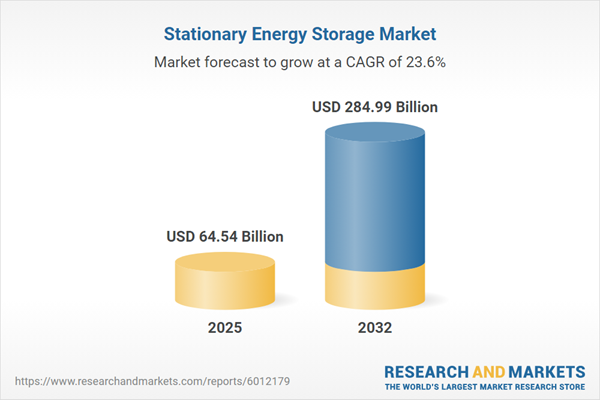Speak directly to the analyst to clarify any post sales queries you may have.
The stationary energy storage market is rapidly transforming how organizations manage energy reliability, risk, and sustainability. As more businesses seek solutions to improve operational resilience and support long-term growth, energy storage systems are becoming an essential pillar of modern energy management strategies.
Market Snapshot: Stationary Energy Storage Market
Between 2024 and 2032, the stationary energy storage market is forecast to expand at a steady global pace, propelled by ongoing advances in battery technology and deployment methodologies. Major progress in lithium-ion and flow battery systems is enabling more commercial, utility, and residential use cases. Market momentum is closely tied to infrastructure modernization, strong demand-side management strategies, and a growing need for reliable power. Industry investments now emphasize flexible architectures that address a range of operational needs and sustainability targets. Leading companies are prioritizing both system reliability and environmental performance, positioning stationary energy storage as foundational to next-generation grid initiatives.
Scope & Segmentation of the Stationary Energy Storage Market
- Battery Technology: Includes flow batteries such as vanadium redox and zinc bromine, lead acid, and advanced lithium-ion chemistries, including lithium iron phosphate, nickel cobalt aluminum, nickel manganese cobalt, and sodium sulfur. Distinct benefits around efficiency, lifespan, and scalability help organizations align solutions to infrastructure and project requirements.
- Applications: Serves commercial, industrial, and residential customers with use cases such as microgrid backup, resilience support, renewable integration, utility-scale deployment, and advanced energy management. Each segment addresses unique operational outcomes and reliability expectations.
- Installation Type: Covers both grid-connected and off-grid systems to support different reliability objectives, compliance needs, and site conditions. This flexibility allows adaptation to varying regulatory and operational contexts.
- Operation Mode: Supports backup power, frequency regulation, load leveling, and peak shaving. These features help organizations maintain continuity and manage expenditure while supporting specific energy strategies and security requirements.
- Capacity Range: Spans solutions from below one megawatt hour to installations above five megawatt hours, providing choice for distributed and centralized models to match business scale.
- Geographies: Adoption occurs in the Americas, Europe, Africa, the Middle East, and Asia-Pacific, with the United States, Brazil, China, Japan, and India as notable leaders. Differences in regulation, infrastructure maturity, and policy shape regional approaches and opportunities.
- Companies Profiled: Key players such as Contemporary Amperex Technology, LG Energy Solution, BYD, Panasonic, Tesla, Samsung SDI, Fluence Energy, ABB, Siemens Energy, and Hitachi Energy set R&D priorities and contribute to evolving industry standards.
Key Takeaways for Senior Decision-Makers
- Stationary energy storage is central to business continuity and sustainability, underpinning operational stability for commercial and utility environments.
- Distributed and behind-the-meter solutions enhance resilience and enable smooth integration of renewable power, offering cost control for critical operations.
- Modular, flexible system designs empower rapid adaptation to market shifts and grid reliability demands.
- Integrating storage into wider business processes opens doors to new offerings and supports evolving regulatory and client expectations.
- Public and private sector collaboration speeds up large-scale deployments, aiding navigation of regulatory and infrastructure complexity.
Tariff Impact and Strategic Supply Chain Shifts
Recent U.S. tariff revisions have led organizations in the stationary energy storage market to adjust supply chain strategies. Growth in North American manufacturing is reducing reliance on imports. As a result, businesses are updating procurement plans, diversifying technology choices, and establishing new supplier partnerships. Targeted investment in battery recycling and second-life initiatives is also bolstering compliance agility and lowering exposure to shifting regulatory and market dynamics.
Methodology & Data Sources
This report is informed by direct interviews with industry executives and technical specialists, rigorous review of scholarly publications, evaluation of official regulatory communications, and proprietary market analysis. The approach ensures the strategic accuracy and reliability of findings for industry stakeholders.
Why This Report Matters
- Helps leaders identify and act on emerging opportunities in the stationary energy storage sector through timely, actionable insights.
- Provides in-depth segmentation and regional perspectives, empowering resource allocation and future infrastructure planning.
- Supports organizations with guidance for innovation, compliance, and developing supply chain flexibility amid changing global dynamics.
Conclusion
As energy reliability and sustainability goals intensify, stationary energy storage is at the core of business strategy. This report delivers decision-ready intelligence to position leadership teams for resilient and informed growth.
Additional Product Information:
- Purchase of this report includes 1 year online access with quarterly updates.
- This report can be updated on request. Please contact our Customer Experience team using the Ask a Question widget on our website.
Table of Contents
3. Executive Summary
4. Market Overview
7. Cumulative Impact of Artificial Intelligence 2025
Companies Mentioned
The companies profiled in this Stationary Energy Storage market report include:- Contemporary Amperex Technology Co., Limited
- LG Energy Solution, Ltd
- BYD Company Limited
- Panasonic Corporation
- Tesla, Inc.
- Samsung SDI Co., Ltd.
- Fluence Energy, LLC
- ABB Ltd
- Siemens Energy AG
- Hitachi Energy Ltd
Table Information
| Report Attribute | Details |
|---|---|
| No. of Pages | 190 |
| Published | November 2025 |
| Forecast Period | 2025 - 2032 |
| Estimated Market Value ( USD | $ 64.54 Billion |
| Forecasted Market Value ( USD | $ 284.99 Billion |
| Compound Annual Growth Rate | 23.6% |
| Regions Covered | Global |
| No. of Companies Mentioned | 11 |









